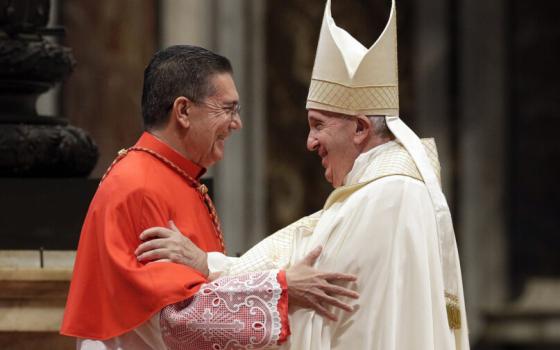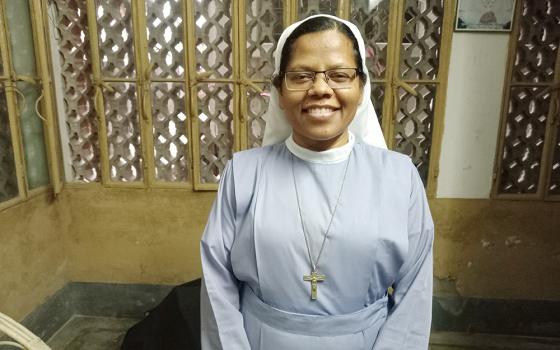
Analysis
It is rare, if not unprecedented, that the Catholic church could take a lesson from a secular university's football program. But the recent events surrounding Penn State's vaunted football culture is indeed instructive on several levels.
For one, it helps explain why the child sex abuse scandal in the church seems never-ending. It also illustrates anew that while legal and administrative responsibilities toward children are ignored at an institution's peril, our moral obligation toward children is paramount and self-evident even in an avowedly nonreligious setting.
Jerry Sandusky, a former assistant football coach at Pennsylvania State University, has been charged with sexually abusing eight young boys over a 15-year period. Two university officials, former athletic director Tim Curley and former finance official Gary Schultz, have been charged with failing to report Sandusky to police after they were told of an incident in 2002.
The parallels between what happened at Penn State and what has happened for decades throughout the Catholic community in the United States and in other countries are striking.
The patterns outlined in the 40-count indictment charging Sandusky are familiar: the grooming of vulnerable youth, using a trusted position and stature within the community to gain access to children and to fend off suspicion, descriptions of fondling and rape of children, reports of abuse being minimized, and a continued toleration of the abuser within a protective culture.
The charges, the description of the offenses and the reactions of those with the authority and power to report the alleged offender to police are interchangeable with those in the grand jury reports and documents both released and still hidden within the culture of the Catholic hierarchy.
The impulses also appear identical. The instinct is to protect first the institution and its prevailing culture at all costs, minimize the offense and ignore the damage to the children involved.
The differences, too, are striking. Penn State University has a board of directors, and it demanded accountability.
Within days of Sandusky's arrest, 84-year-old Joe Paterno, one of the most celebrated and revered coaches in modern college football history, was gone. His offense? He didn't do enough. He wasn't charged with a crime. In fact, it is reported he told superiors of one incident. But he didn't go to the police, didn't follow up to see what had been done and didn't pursue concern about the welfare of the children involved.
He was fired along with Graham B. Spanier, described in a New York Times report as "one of the longest-serving and highest-paid university presidents in the nation, who has helped raise the academic profile of Penn State."
In contrast, in the ongoing abuse crisis in the church, only one bishop who oversaw a cover-up, Cardinal Bernard Law, was removed from a position after public outrage and the outrage of his priests in Boston reached such a pitch that the Vatican had to do something. That something was to transfer him to a cushy position in Rome, where it was easier for him to get to the meetings of the six influential Vatican congregations -- offices in the Vatican bureaucracy -- on which he was allowed to retain membership.
He recently hosted a lavish party in Rome to celebrate his 80th birthday. It was attended by some of the top figures within the Vatican bureaucracy.
Cardinal Anthony Joseph Bevilacqua, who oversaw the cover-up of hideous crimes against children committed by numerous Philadelphia priests, was able to slip quietly into retirement on the grounds of St. Charles Borromeo Seminary in Overbrook, a suburb of Philadelphia. The Vatican never uttered a word of reprimand for the institutional harm to children that he helped to hide during his tenure and that is detailed in a Philadelphia grand jury report.
His successor, Cardinal Justin Rigali, and some in his administration repeatedly violated the bishops' own norms for handling sex abuse and repeatedly misrepresented to the public the nature and extent of the problem. A second grand jury report resulted in the indictment of Msgr. William Lynn, former vicar for clergy, for failing to remove abusive priests. He was at the time the highest-ranking Catholic clergyman charged in the scandal.
Rigali recently slipped quietly into retirement. Again, no word of rebuke from the Vatican.
Bishop Robert Finn of the Diocese of Kansas City-St. Joseph, Mo., became the highest-ranking clergyman charged in the abuse scandal when he and the diocese were indicted for failing to report child abuse. But Finn is staying in place, determined to run the diocese, and apparently no one can tell him, much less force him, to step aside for the good of the church while dealing with his legal entanglements.
No word of rebuke has issued -- not from fellow bishops nor from Rome -- of Bishop Fabian Bruskewitz of Lincoln, Neb., who has flatly refused to comply with the minimal controls put in place by the United States Conference of Catholic Bishops during its spring meeting in Dallas in 2002.
And former Los Angeles Cardinal Roger Mahony has been allowed to quietly slip off the national stage while leaving behind a mountain of documentation that would blow the lid of the archdiocese if released, say prosecutors, victims' lawyers and others involved in assessing cases. No one knows quite how much has been spent keeping the documents -- which were supposed to be released as part of an earlier settlement agreement -- under wraps.
No board of directors exists to demand accountability of the bishops.
As the story unraveled out of Penn State, one repeatedly heard former players and football commentators, people most familiar discussing Xs and Os, outraged at the "moral" failures of those entrusted with protecting youth. Paterno had done what he was supposed to do, said one, but had he done what he was morally obliged to do?
Where were his and the president's concern for the children involved? To what lengths did they go to find out the status of the children involved? What did they do to assure that the alleged predator would be taken out of circulation? That more children would not be abused?
Not enough, on anyone's scorecard, and particularly not on those of the board entrusted with overseeing the institution.
It is certainly plausible and even probable that the directors and others within the Penn State community were influenced in its actions by what has occurred in Catholic circles. Denial, cover-up, excuses simply don't work. They merely extend the crisis and drain the institution of credibility.
Another significant difference between what has happened in the Catholic community and what occurred at Penn State is that the latter did not have several hundred more football cultures to which Coach Sandusky could be secretly transferred. It can't pass errant coaches through an international, secretive culture that claims a connection with divinity that places it beyond the reach and mores of mere mortals. Penn State's options were limited.
Perhaps Paterno was treated too harshly for someone who's given the university so much. His supporters, like the parishioners who can't imagine their priest abusing children or those who support bishops without question, were out in force after his firing was announced. But Washington Post columnist Thomas Boswell placed that sentiment in perspective: "Paterno has been a man above authority at Penn State for decades. He's been allowed to be selectively deaf or dumb or blind when it suits him. Those days are over."
He recounts in a Nov. 10 piece that police in 1998 were notified by the mother of an 11-year-old child who had showered with Sandusky. A university policeman reported overhearing a conversation between Sandusky and the mother in which the coach admitted, "I understand I was wrong. I wish I could get forgiveness. I know I won't get it from you. I wish I were dead."
Writes Boswell: "I'd call that a red flag -- and every other color in the moral-alarm spectrum. Penn State's decision was to close the investigation, bring no charges and not call the police or other outside authorities."
Sound familiar?
Another eerie similarity in all of this is that both institutions -- church and university -- acted first to protect themselves, the reputations of their programs and the personnel involved. The church, additionally, acted to protect its treasury. The irony, of course, is that in both cases, hiding the truth at the outset only led to the opposite of their intent. Reputations are in tatters and, in the case of the church, the treasury has been drained.
Penn State will live on with a new football coach and a new president. The community, however, will have been put on notice that placing children in jeopardy will be dealt with in the most severe way, and that those in charge will not be able to hide behind excuses. The lines are clear. The expectations unambiguous. The story in all of its detail will be known.
The church, too, will certainly live on. But under the lingering cloud of suspicion that bishops, no matter how incompetent or unresponsive to reports of abuse, will not face the prospect of losing their jobs or of having to be accountable. The community will have to continue to function with the understanding that it might never know the full story. It also knows that no board of directors will ever convene with the power to look beyond the interests of an individual bishop and take the drastic measures necessary for the greater good of the community.
[Tom Roberts is NCR editor at large. His email address is troberts@ncronline.org.]



